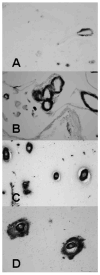Cerebral amyloid angiopathy pathology and cognitive domains in older persons
- PMID: 21387377
- PMCID: PMC3228518
- DOI: 10.1002/ana.22112
Cerebral amyloid angiopathy pathology and cognitive domains in older persons
Abstract
Objective: To examine the relation of cerebral amyloid angiopathy (CAA) to cognitive domains in older community-dwelling persons with and without dementia.
Methods: Subjects were 404 persons in the Religious Orders Study, a cohort study of aging, who underwent annual clinical evaluations, including 19 neuropsychological tests from which 5 cognitive domain and global summary scores were derived, and brain autopsy at time-of-death (mean age-at-death 86). Using amyloid-β immunostaining, CAA severity was graded in 5 regions (midfrontal, inferior temporal, angular, calcarine, and hippocampal cortices), as 0 = none, 1 = mild, 2 = moderate, 3 = severe, and 4 = very severe. Because severity was related across regions (all r(s) > 0.63), and almost all persons had some CAA, we averaged regional CAA scores and created class variable predictors for no-to-minimal (<0.5), mild-to-moderate (0.5-2.5) and moderate-to-very severe CAA (>2.5).
Results: CAA was very common (84.9%; 94 had no-to-minimal, 233 mild-to-moderate, and 76 moderate-to-very severe disease) and was related to AD pathology (r(s) = 0.68). In linear regression analyses controlling for age, sex, education, AD pathology, infarcts, and Lewy bodies, moderate-to-very severe CAA was associated with lower perceptual speed (p = 0.012) and episodic memory (p = 0.047), but not semantic memory, working memory, visuospatial skills, or a composite of all cognitive measures. No associations of mild-to-moderate CAA with cognition were found. Dementia did not modify these findings.
Interpretation: CAA pathology is very common in older community-dwelling persons and is associated with AD pathology. Moderate-to-very severe CAA, but not mild-to-moderate CAA, is associated with lower performance in specific cognitive domains, most notably perceptual speed, separately from the effect of AD pathology.
Copyright © 2010 American Neurological Association.
Conflict of interest statement
Figures

References
-
- Vinters HV, Gilbert JJ. Cerebral amyloid angiopathy: incidence and complications in the aging brain. II. The distribution of amyloid vascular changes. Stroke. 1983;14:924–928. - PubMed
-
- Ellis RJ, Olichney JM, Thal LJ, et al. Cerebral amyloid angiopathy in the brains of patients with Alzheimer's disease: the CERAD experience, Part XV. Neurology. 1996;46:1592–1596. - PubMed
-
- Itoh Y, Yamada M, Hayakawa M, et al. Cerebral amyloid angiopathy: a significant cause of cerebellar as well as lobar cerebral hemorrhage in the elderly. J Neurol Sci. 1993;116:135–141. - PubMed
-
- Olichney JM, Hansen LA, Hofstetter CR, et al. Cerebral infarction in Alzheimer's disease is associated with severe amyloid angiopathy and hypertension. Arch Neurol. 1995;52:702–708. - PubMed
Publication types
MeSH terms
Substances
Grants and funding
LinkOut - more resources
Full Text Sources
Other Literature Sources
Medical

